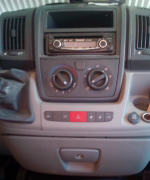Barrie,
My curiousity was aroused, as to the location of the heater/aircon fan earth connection. Having delved into and under the dash of my x244 on many occasions, I could only recall 3 earth points, two just inside the wheel arches, and a third to the LEFT of the heater. eLearn indicated that C016 (same number as on x250) was immediately to the RHS of the heater. No earth visible in that location, and I have been under that area a lot recently, when changing the brake pedal switch.
I therefore applied a clip on DC ammeter to the earth wire at the left of the heater fan, and switched the fan on. Bingo! 10A with fan on full speed.
I appreciate that the x250 may be different, but it is probably worth a good look if you can get your head under there with a torch. All 3 of the original earth points that I have found are to M8 studs which also support the steel dash framework. Please note that Fiat have used M8 nuts requiring a 12mm spanner, instead of the more usual 13mm.
The two outer earth points are visible from under the dash, but not immediately accessible. However the heater fan earth, C016, is accessible on my x244 without any dismantling.
As regards wire size eLearn gives 2.5 sq mm for the x244. Probably about 3.5mm external diameter.
As regards eLearn, having found several errors in the electrical diagrams, and misleading component locations, I use it as a guide only.


